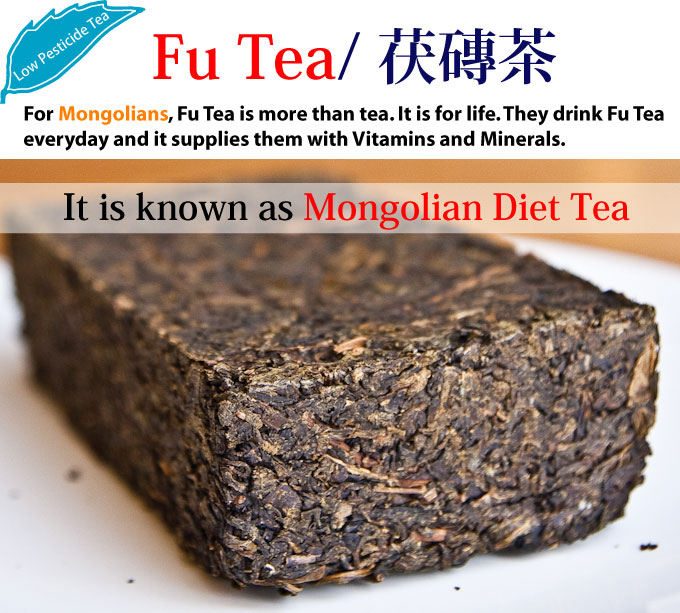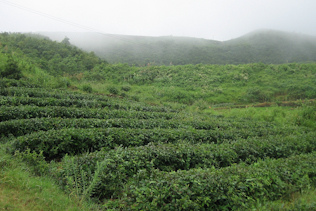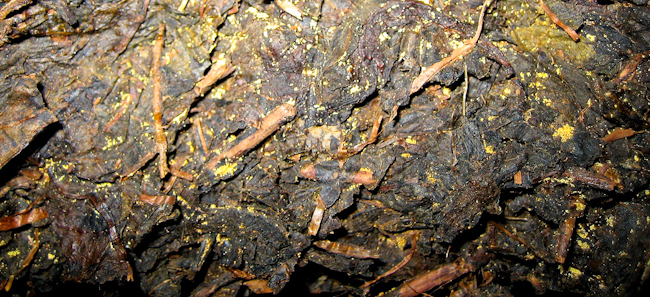
Thank you for visiting HOJO website. If you have any enquiry, please feel free to get in touch with us at
▼ Akira Hojo
▼ Hojo Newsletter
▼ HOJO FACEBOOK






In Mongolia, there is nothing but desert, where no sufficient vegetable are available. Due to the cold environment, people always eat meat and oily food. Can they still sustain their health? That's why they drink Fu Tea
The original name of Fu Tea is called Fuzhuan Cha. Zhuan means “brick” in Chinese. Literally, Fuzhuan Cha means “Fu brick tea” in Chinese. This tea is called Fuzhuan Cha since tea is always processed and compressed into brick form. Some of you might wonder, what is the meaning of “Fu”? Fu Tea was once known as Hu Cha because it was produced in Hu-nan province. It was later given the name Fu Tea because in the old days, the tea makers of Fu Tea specially selected Fu-day (伏天) to process the tea. Fu-day is the hottest day in summer. There are only 3 Fu-day in every lunar year.
Production of Fu Tea began since 1860 in Hunan province. Originally, this tea was meant for exportation to other provinces, especially to West-North area of China. In order to ease the carriage of tea during transportation, tea leaves were compressed into brick form. Even until today, Fu Tea is still widely consumed and favored by Mongolians, Xinjiangese and people from Qing-hai and Ning-xia province. This tea is also very popular in Sichuan province. Usually the quality of Fu Tea consumed by locals is of lower quality. Fu Tea is compressed into various sizes. Usually the smaller the size of brick is, the higher the quality. The smallest brick is in 200g and this is the quality we introduced. The size of brick and its quality is set according to the harvesting season of tea leaves. The differences in quality are reflected in its flavor and the intensity of aftertaste. The good quality Fu Tea gives a hint of Chinese dates like flavor, combined with a mild woody scent. It also gives much longer lasting taste than the normal quality. Unlike ordinary brick tea, good quality Fu Tea is not astringent at all.
The living environment in this area is very cold and harsh and people who live here lost a lot of calories. Besides, fresh vegetables are rare and hard to obtain. Eventually people who live in desert and high mountain area tend to have a lot of meat in their daily meal. In general their diet contains a lot of oil and fat. For those whom lack fresh greeneries in their diet, Fu Tea is a very important source of minerals and organic substances such as pro-vitamins, which is vital to health.
Various researches studied that conjugated poly phenol in Fu Tea helps to reduce sugar intake. As a result, this tea will help to lower blood sugar level in our body. It does not really reduce existing sugar, but to reduce sugar intake from food into our body. In our body metabolism, sugar derives from carbohydrate. The hydrolysis of carbohydrate into sugar involves various enzymes. Starch, as it is often explained as “net”, is broken into single chain, which is called dextrose. The dextrose is further broken into smaller molecules such as oligosaccharide and then finally it will be further converted into sugar or glucose. A number of various enzymes involved in different stages of sugar metabolism. According to health study, Fu Tea works on the enzyme that is in-charge of hydrolysis of sugar. Enzyme misunderstands particular substances in Fu Tea as sugar and eventually less sugar is produced from carbohydrate.
Basically the reduction of blood sugar causes lack of energy in our body metabolism. As a result, our body system needs to burn existing fat and cholesterol stored inside our body in order to supply sufficient energy for normal body metabolism. To explain this in a simpler way: sugar is like “cash”, while fat is like a “fixed deposit”. If there is insufficient “cash” to use, we have to get money from our “fixed deposit”.
Thanks for the effectiveness of Fu Tea in lowering blood sugar, some people enjoy this tea not only for its taste and flavor, but also for its unique functional health effect.
Fu Tea is categorized as “dark tea”. Dark tea is refers to tea that undergoes secondary fermentation. In the beginning stage of the process of Fu Tea, freshly plucked tea leaves are pan-fried in order to inactivate the enzymes. At this point, the tea is categorized as green tea since the fresh tea leaf is heated at once and no enzymatic oxidation takes place. The tea leaves are treated like processing ordinary green tea. Usually most of tea such as green tea, oolong tea and black tea is dried with hot air or heat-dried during its manufacturing process. Due to the high temperature caused during heat-drying process, all remaining enzymes will be completely inactivated.
On the other hand, the drying process for dark tea is conducted under the sun. Due to the moderate heat, further fermentation is taken place by the remaining enzymes during sun-drying process. This is the key element that differentiates dark tea from both the green tea and black tea.
Most of us tend to think that pan-frying is effective enough to inactivate enzyme, as it is the objective of this process. However heat generated from frying pan is not as hot as the heat from steam. Unlike Japanese green tea that involves steaming method to inactivate the enzymes in the tea leaves, pan-fried tea still contains some remaining minor amount of enzymes inside the leaves that survived the heating process.
After sun-drying process, tea leaves are piled inside a store room for nearly 1 year in order to get it further matured. It is just like keeping rice straw for a long period, the maturing process will convert the original greenish smell of tea leaf to be very flowery and fruity aroma.
 |
 |
|
The tea garden of Fu Tea: It is located deep inside the mountain. |
Tea leaf after maturation process |
After the maturing period, the crude dark tea is then sent for compressing process. Before compression, the tea leaves will be steamed for the second time in order to further soften the tea leaves and ease the compression. After steaming, the tea leaves will be compressed in the casing. This step is one of the crucial stages in determining the quality of Fu Tea. The brick tea must be compressed with the right pressure so that the tea leaves are not too loose and not too tight. The brick must be compressed to an appropriate tightness in order to promote the growth of mold during fermentation. The compressed brick will be then kept in a warm and humid room for further fermentation. This room will be strictly monitored in order to maintain the room temperature and humidity favorable to the growth of mold. If any of these conditions is running out of control, the fermentation will not be successfully taken place. During this stage, a specific type of mold will start growing, producing spores that are called “Golden Flower” (Jin Hua). The quantity of golden flower is the quality index of Fu Tea. The mold also produces organic acid during fermentation. The acid influences a lot on the elution of mineral ions and hence, the amount of mold presence inside the brick tea will eventually dictate the quality identity of Fu Tea.
 Good tea has "golden flower" when tea is cut.
Good tea has "golden flower" when tea is cut.
In you are using tap water, it is necessary to filter the water using an activated carbon filter. If not, you wouldn’t be able to enjoy the authentic taste of tea. Chlorine is added to tap water in order to sanitize bacteria. This chlorinated water will also harm our body cells. Concerning about our health condition, it is very important to remove chlorine from drinking water. The most effective method in removing chlorine is to install an activated carbon filter. This type of filter is designed for removing organic substance. It will remove not only chlorine, but also other harmful substance such as contaminated pesticide. The activated carbon filter can be easily obtained from the common hardware shop in most countries. If activated carbon filter is not available, please place a charcoal inside the water and leave it for over night. The material composed of activated carbon filter is made of ground charcoal. The difference is that activated carbon filter contains much finer particles and hence it has extremely large surface area for a better efficiency in filtration. We do not suggest RO water (reversed osmosis water) or distilled water. This water carries no mineral, the taste and flavor of tea tends to be very unstable, unless you have very superior quality tea and tea equipment.
In the long run, you may observe a thick layer of scale accumulated inside your kettle. Our mother usually taught us to wash and remove it with citric acid. But please do not even try to remove the scale. Scale consists of minerals that exist in the water. The mineral composition is reflected from the water you used. If you remove the scale, the mineral ion balance between scale and water is destroyed. This balance is called buffer effect in science. The flavor and taste will seriously run out and you won’t be able to get previous taste and flavor for a long time. It is also important to stick to the same type of water whenever brewing tea. If source of water is changed, it carries different type of minerals. It will affect the mineral ion balance too.
Go to further information about suitable water for brewing tea >>
To determine the quantity of tea leaves to be used, we divide the volume of water by 40. For example: the volume of teapot = 200ml; 200ml/40 =5g. You need to measure 4g of tea leaves for 200ml of water.
Rinse tea pot with boiling water for 10 seconds in order to warm it up. After 10 seconds, remove hot water from the warmed tea pot.
Pour boiling water onto tea leaf up to more than 70% of the volume of tea pot. It is not for washing purpose, but to warm up the tea leaf so that leaf will unfurl to release its flavor and taste. Once again pour off hot water within 7 to 10 seconds.
Brewing Time
1st: 60 seconds
2nd brewing onwards: Less than a few second. You just need to run though hot water with tea.
Note: Please remove the lid while you are waiting for subsequent brewing. Tea leaf will be over steamed and get oxidized if the lid is not removed.
Once a bag of tea is opened, Tea should be kept in ambient and dry conditions such as in the living room, but it must be completely away from humidity. Tea should not be kept in the kitchen as the environment is very humid. Avoid enclosed area such as inside the cupboard or drawer as these places are damp. Also avoid opening the bag of tea in humid atmosphere. It is recommended to open the bag during a sunny day or under air-conditioned atmosphere. Once tea leaves absorb moisture, deterioration of tea will be triggered within a few days. Tea will then give an astringent taste, sometime it tastes sour. The fresh aroma also becomes weaker.
Traditionally, Pu-erh tea is compressed to remove oxygen from the leaves and kept it intact. It was the wisdom of ancient people to keep tea without oxygen and let it matured very well.
From scientific point of view, oxidation does not only refer to receiving oxygen. The oxidation also takes place when it releases hydrogen and receives electron. Even if tea is kept without oxygen, it will still undergo oxidation.
In 1960's, generally Pu-erh tea was compressed tightly and shaped like a bing (flat and thin round cake). It was called “iron bing”. The tea leaf was compressed extremely tight until it became like a piece of stone; we can hardly pry it even if we use the proper tool that designed for prying the Pu-erh cake. This style of compression succeeded the elimination of oxygen from the tea leaves. If you have ever tried this kind of Pu-erh iron bing, you would know that it was very well-matured. It gives flavour like honey with fruity note and gives no earthy flavour at all. The only problem is that it is so difficult to loosen the leaves from the iron bing and the leaves are often damaged during the process.
On the other hand, nowadays most of Pu-erh cakes are loosely compressed. Some of the Pu-erh cakes can be easily break apart by fingers. Obviously there is oxygen remained in between the leaves. If we keep loosely-compressed Pu-erh in ambient environment, tea will expose to not only oxygen but also moisture and develop unwanted oxidation that usually generates earthy flavour. To achieve the same maturation effect like the iron bing, we encourage customer to keep Pu-erh tea without oxygen. With modern technology, we are able to apply the same theory. Some people in Taiwan intentionally keep high mountain oolong in the vacuum bag for a few years. In the beginning, high mountain oolong is green in colour and it gives a delightful fresh flowery flavour. After a few years of maturation, the leaves turn into yellow colour and it gives the flavour like ripen peach or apricot. This is exactly the same effect as what we are looking for in Pu-erh tea. Based on our experience, well-matured Pu-erh tea gives a very fruity flavour and no earthy or mouldy flavour at all.

Please feel free to send us e-mail for enquiry at:

 |
We accept various kinds of credit card through Paypal.
Only if customer prefer other option of payment, we suggest "Bank Transfer".
Various choice of shipping method
EMS, SAL, Small Packet, Small Packet (SAL) Yamato Express and Surface
For shipping tea, we usually suggest small air parcel, the estimated shipping cost of tea in 100g (with wrapping material ) is
Small Parcel
USA JPY 600, EU JPY600 and Asia JPY470
Small Packet (SAL)
USA JPY380, EU JPY380 and Asia JPY320
The shipping fee to oversea by small air parcel happens to be even cheaper than domestic shipping fee in Japan.
For your information, some countries, EU in particular imposes custom duty. We need buyer to bare the duty. We are sorry, but we cannot change the amount on the invoice, and we do not mark any packages as gifts. We will strictly follow the custom regulation.
A GIFT FROM THE MOUNTAIN
since 2006
Copyright (C) 2006-2007 HOJO co.,ltd. All Rights Reserved.